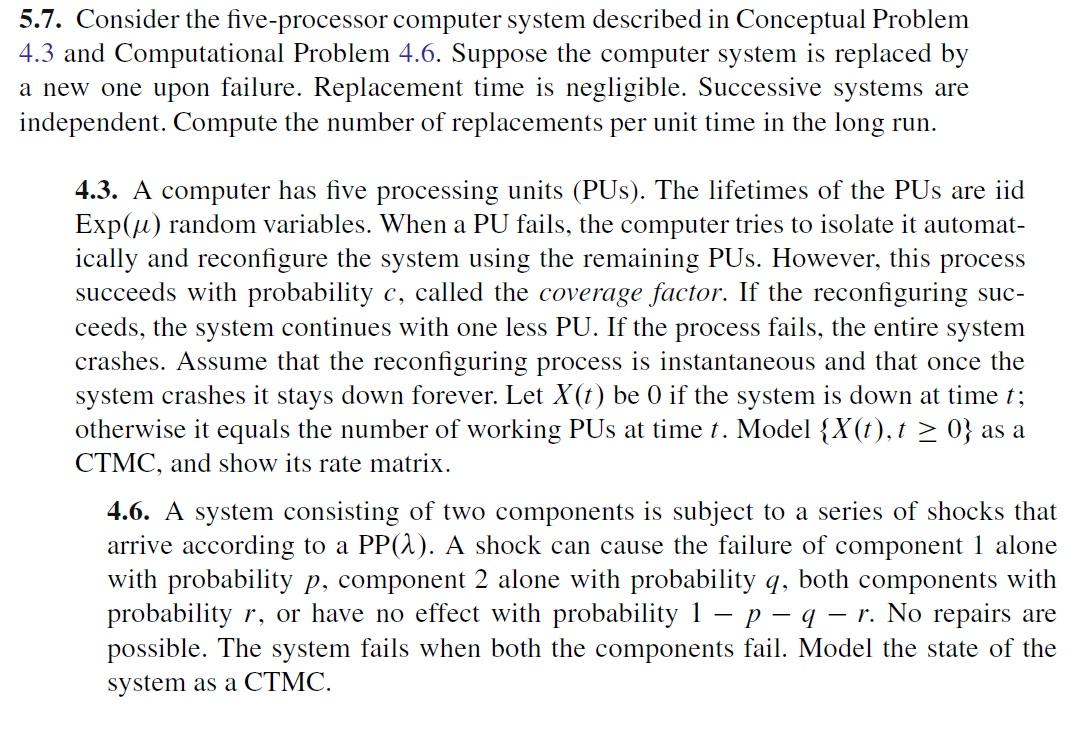Answered step by step
Verified Expert Solution
Question
1 Approved Answer
Kulkarni page 181, 5.7 5.7. Consider the five-processor computer system described in Conceptual Problem 4.3 and Computational Problem 4.6. Suppose the computer system is replaced

Kulkarni page 181, 5.7
5.7. Consider the five-processor computer system described in Conceptual Problem 4.3 and Computational Problem 4.6. Suppose the computer system is replaced by a new one upon failure. Replacement time is negligible. Successive systems are independent. Compute the number of replacements per unit time in the long run. 4.3. A computer has five processing units (PUs). The lifetimes of the PUs are iid Exp(u) random variables. When a PU fails, the computer tries to isolate it automat- ically and reconfigure the system using the remaining PUs. However, this process succeeds with probability c, called the coverage factor. If the reconfiguring suc- ceeds, the system continues with one less PU. If the process fails, the entire system crashes. Assume that the reconfiguring process is instantaneous and that once the system crashes it stays down forever. Let X(t) be 0 if the system is down at time t; otherwise it equals the number of working PUs at time t. Model {X(t), t > 0} as a CTMC, and show its rate matrix. 4.6. A system consisting of two components is subject to a series of shocks that arrive according to a PP(a). A shock can cause the failure of component 1 alone with probability p, component 2 alone with probability q, both components with probability r, or have no effect with probability 1 - p - q - r. No repairs are possible. The system fails when both the components fail. Model the state of the system as a CTMC. 5.7. Consider the five-processor computer system described in Conceptual Problem 4.3 and Computational Problem 4.6. Suppose the computer system is replaced by a new one upon failure. Replacement time is negligible. Successive systems are independent. Compute the number of replacements per unit time in the long run. 4.3. A computer has five processing units (PUs). The lifetimes of the PUs are iid Exp(u) random variables. When a PU fails, the computer tries to isolate it automat- ically and reconfigure the system using the remaining PUs. However, this process succeeds with probability c, called the coverage factor. If the reconfiguring suc- ceeds, the system continues with one less PU. If the process fails, the entire system crashes. Assume that the reconfiguring process is instantaneous and that once the system crashes it stays down forever. Let X(t) be 0 if the system is down at time t; otherwise it equals the number of working PUs at time t. Model {X(t), t > 0} as a CTMC, and show its rate matrix. 4.6. A system consisting of two components is subject to a series of shocks that arrive according to a PP(a). A shock can cause the failure of component 1 alone with probability p, component 2 alone with probability q, both components with probability r, or have no effect with probability 1 - p - q - r. No repairs are possible. The system fails when both the components fail. Model the state of the system as a CTMCStep by Step Solution
There are 3 Steps involved in it
Step: 1

Get Instant Access to Expert-Tailored Solutions
See step-by-step solutions with expert insights and AI powered tools for academic success
Step: 2

Step: 3

Ace Your Homework with AI
Get the answers you need in no time with our AI-driven, step-by-step assistance
Get Started


